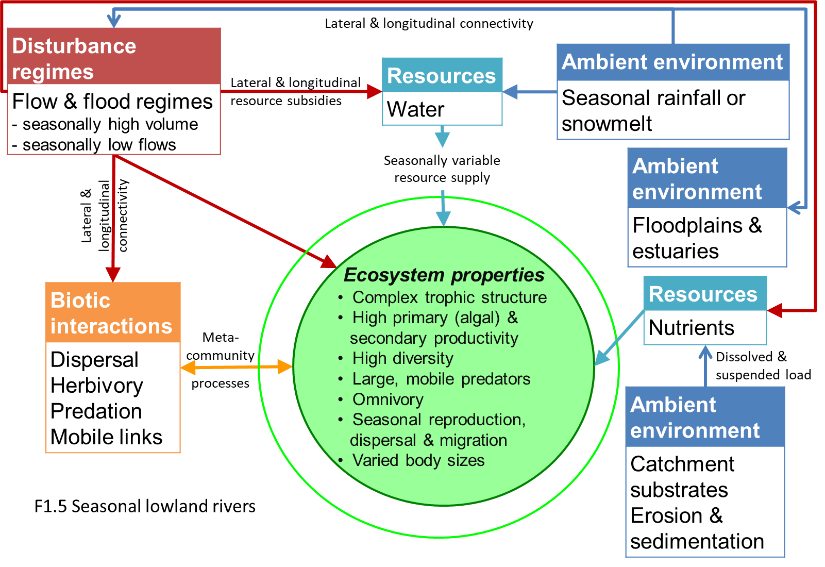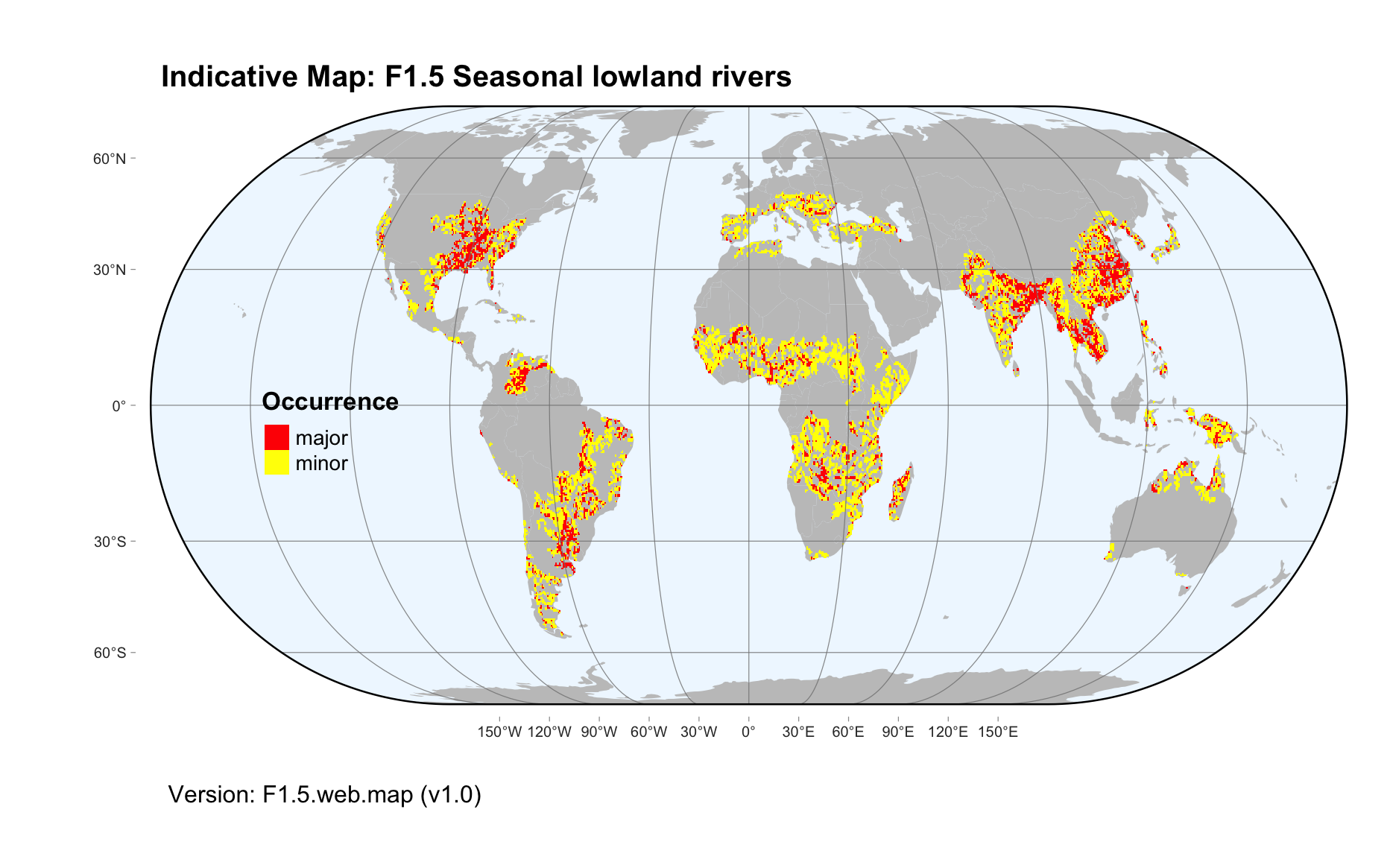Global ecosystem typology
Alternative site for the Global ecosystem typology with additional information for ecosystem profiles and indicative maps.
This site is maintained by jrfep
F1.5 Seasonal lowland rivers
Biome: F1. Rivers and streams biome
Contributors:
(texts)
These medium to large rivers in tropical, subtropical and temperate lowlands have markedly seasonal flows due to seasonal water supply in the catchments. Their single or multi-channelled forms link to floodplain wetlands, and transport large floods during wet seasons: summer in the tropics or winter-spring in temperate latitudes. Productivity is high, both within channels and on connected floodplains, with algae and aquatic plants supporting complex food webs, and providing seasonal nurseries for breeding animals.
Key Features
Highly productive large rivers with seasonal hydrology large floodplain subsidies. Short food chains support large mobile predaors.
Overview of distribution
Tropical, subtropical and temperate lowlands.
Profile versions
- v1.0 (2020-01-20): RT Kingsford; DA Keith
- v2.0 (2020-05-24): RT Kingsford; B Robson; PS Giller; AH Arthington; DA Keith
- v2.01 ():
- v2.1 (2022-04-06): RT Kingsford; B Robson; PS Giller; AH Arthington; DA Keith Full profile available at official site
Main references
Selected references for this functional group:
Douglas MM, Bunn SE, Davies PM (2005) River and wetland food webs in Australia’s wet-dry tropics: general principles and implications for management Marine and Freshwater Research 56: 329-342 DOI:10.1071/mf04084
Layman CA, Winemiller KO, Arrington DA, Jepsen DB (2005) Body size and trophic position in a diverse tropical food web Ecology 86:2530-2535 DOI:10.1890/04-1098
Datry T, Bonada N, Boulton A (2017) Intermittent rivers and ephemeral streams: ecology and management (Academic Press: Burlington)
Diagrammatic assembly model

Maps
Maps are indicative of global distribution patterns are not intended to represent fine-scale patterns. The maps show areas of the world containing major (coloured red) or minor occurrences (coloured yellow) of each ecosystem functional group. See general notes on maps.
There are 2 alternative versions of the indicative map for this functional group, please compare description and sources below.
F1.5.IM.grid_v2.0
Datasets
- GSW-1.1
- HydroAtlas-1.0
- FEOW-2008
Map references
Pekel JF, Cottam A, Gorelick N, Belward AS (2016) High-resolution mapping of global surface water and its long-term changes Nature 540, 418-422 DOI:10.1038/nature20584
Linke, S., Lehner, B., Ouellet Dallaire, C., Ariwi, J., Grill, G., Anand, M., Beames, P., Burchard-Levine, V., Maxwell, S., Moidu, H., Tan, F., Thieme, M. (2019) Global hydro-environmental sub-basin and river reach characteristics at high spatial resolution Scientific Data 6: 283 DOI:10.1038/s41597-019-0300-6
Abell R, Thieme ML, Revenga C, Bryer M, Kottelat M, Bogutskaya N, Coad B, Mandrak N, Contreras Balderas S, Bussing W, Stiassny MLJ, Skelton P, Allen GR, Unmack P, Naseka A, Ng R, Sindorf N, Robertson J, Armijo E, Higgins JV, Heibel TJ, Wikramanayake E, Olson D, López HL, Reis RE, Lundberg JG, Sabaj Pérez MH, Petry P (2008) Freshwater ecoregions of the world: A new map of biogeographic units for freshwater biodiversity conservation, BioScience 58: 403–414. DOI:10.1641/B580507
F1.5.web.map_v1.0

Datasets
- GSW-1.1
- HydroAtlas-1.0
- FEOW-2008
Map references
Pekel JF, Cottam A, Gorelick N, Belward AS (2016) High-resolution mapping of global surface water and its long-term changes Nature 540, 418-422 DOI:10.1038/nature20584
Linke, S., Lehner, B., Ouellet Dallaire, C., Ariwi, J., Grill, G., Anand, M., Beames, P., Burchard-Levine, V., Maxwell, S., Moidu, H., Tan, F., Thieme, M. (2019) Global hydro-environmental sub-basin and river reach characteristics at high spatial resolution Scientific Data 6: 283 DOI:10.1038/s41597-019-0300-6
Abell R, Thieme ML, Revenga C, Bryer M, Kottelat M, Bogutskaya N, Coad B, Mandrak N, Contreras Balderas S, Bussing W, Stiassny MLJ, Skelton P, Allen GR, Unmack P, Naseka A, Ng R, Sindorf N, Robertson J, Armijo E, Higgins JV, Heibel TJ, Wikramanayake E, Olson D, López HL, Reis RE, Lundberg JG, Sabaj Pérez MH, Petry P (2008) Freshwater ecoregions of the world: A new map of biogeographic units for freshwater biodiversity conservation, BioScience 58: 403–414. DOI:10.1641/B580507
Check: the Glossary / Profile structure / the public document